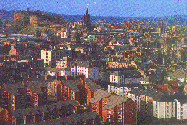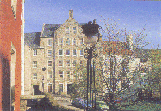 Castlehill and Lawnmarket
Castlehill and Lawnmarket Castlehill and Lawnmarket
Castlehill and Lawnmarket

ON leaving the Castle Esplanade we immediately enter the Royal
Mile. This is the popular name given to the fascinating string of
historic streets which, linking the two royal residences of castle and
Holyrood Palace, was the thoroughfare of medieval Edinburgh. The Royal
Mile was where the action was! Here you would find street stalls,
taverns, royal processions, thieves, street entertainers, beggars,
public hangings, riots, the unpopular Town Guard, soldiers from the
castle, merchants, foreigners, fine town houses of the nobility, and
the law courts.
Today the Royal Mile retains its distinctive character, thanks to a
durable architectural profile and a policy of careful
conservation. The rehabilitation of many of the area's historic
buildings as residences during the past 60 years has provided a firm
foundation for a thriving modern community.

A View from Salisbury Crags
It is not difficult in the Old Town to sense an earlier age, particularly when wandering the many narrow closes and wynds that run at right angles from the Royal Mile. These closes, every one of which has a tale attached to it, usually open into courtyards, characteristic of a bygone lifestyle. Different social classes often were neighbours in these tenement buildings, which had a common entrance from the public street.
In the early years of the present century, a period when much of the Old Town had deteriorated to slum property, many a destitute family still sat by an ornate fireplace inscribed with the coat of arms of a half-forgotten noble family.
At the very top of the Royal Mile is Castlehill, a fairly short street in which one of the most interesting buildings is the Outlook Tower. It is one of a number in this immediate area associated with Sir Patrick Geddes (1854-1932), a Scot who has been called the father of modern town planning. Geddes' enlightened ideas and practical teaching, particularly about urban living, had great influence, not only in Scotland but far beyond these shores, including France, the Middle East and India.
At the top of the Outlook Tower is the famous
Camera Obscura,
installed in 1853. In a dark chamber, the camera's system of revolving
lenses and mirrors projects a moving image of the surrounding city
before the audience, while the operator tells the story of the city's
historic past.
The story of Scotch whisky is entertainingly explored at the Scotch Whisky Heritage Centre, at 354 Castlehill. During a visit lasting about one hour, the visitor steps back into history and sees the development of this famous beverage through the centuries. Travelling in an electric barrel car, the visitor makes a journey of discovery through the social and industrial history of whisky.
At the junction of Castlehill and Johnston Terrace soars Tolbooth St John's, a church designed by Augustus Pugin. Its tremendous yet graceful spire will be found in most of Edinburgh's famous skylines.
The Lawnmarket, whose name is thought to indicate the recognised centre in olden times for trading in linen, offers a good example of the system of closes, tenemented 'lands' and courtyards that characterise the Old Town.
The most notorious denizen of this neighbourhood was Major Thomas Weir, who in the seventeenth century lived in the West Bow with his sister, Grizel. Weir, though a grim-looking figure, was outwardly a pious man, and highly thought of for his devout prayers and powerful preaching. Wrapped in his long cloak, he would habitually lean on a staff while delivering his sermons. There was, therefore, stunned disbelief when he broke down and confessed to the most revolting crimes. Grizel confessed to practising witchcraft. People swore that the major's staff had a life of its own, carrying out his orders and proceeding down the Lawnmarket independently of its master. After his trial in 1670, during which the evidence was sensational, Major Weir was convicted of sorcery and sentenced to be strangled and burnt; Grizel was hanged in the Grassmarket. The wizard's staff was consigned to the flames with its master but, it is said, was consumed only with difficulty.
On the north side of the Lawnmarket is Mylne's Court. Named after its architect, master mason to Charles II, it is among the oldest surviving in Edinburgh and conveys the modest scale upon which life in the Old Town was lived. Today the interiors of these buildings have been modernised to provide residential flats for students of Edinburgh University.
More spacious is nearby James Court, which houses the Writers' Museum. This interesting house dates from 1622. In the eighteenth century it was the home of Lady Stair, the widow of the first Earl of Stair. Today it is the municipal museum principally known for its collection of artefacts associated with three Scottish men of letters - Sir Walter Scott, Robert Louis Stevenson (both natives of Edinburgh) and Scotland's national bard, Robert Burns. Burns lodged only a few yards away, in the Lawnmarket, during one of his successful visits to the Scottish capital - there is a commemorative plaque above street level.
Also on this side of the Lawnmarket is
Gladstone's Land, owned by the
National Trust for Scotland. Built by Thomas Gledstanes, it is well
worth visiting as a skilfully restored example of a merchant's house
of the seventeenth century. Interesting painted ceilings are one of
its features.
On the other side of the street is Riddle's Court, which dates from
the sixteenth century and is noted for the stair tower in its inner
courtyard. A pend leads to Bailie McMorran's House (sixteenth
century), the home of a leading citizen of the time. His name is best
remembered today for the manner of his death: a magistrate, he
proceeded to the Royal High School to quell a riot among the students
in 1595 and was shot dead by one of the schoolboys. So much for the
myth of superior classroom discipline in the old days.

Chessel's Court
Also on the south side of the Lawnmarket is Brodie's Close. It is
named after a respectable craftsman, Francis Brodie, but it is his
son, William, whose name and deeds everyone remembers. This is because
William Brodie, ostensibly a respectable member of the Town Council,
was discovered to be a professional burglar on a grand scale. Deacon
Brodie was unmasked as the result of an unsuccessful armed raid on the
Excise Office at Chessel's Court, off the Canongate. Brodie managed to
escape to Holland but was arrested there, brought back for trial,
convicted and hanged in public in the High Street in 1788.
The final irony was that Brodie was executed with an improved version
of the gallows which he invented. Deacon Brodie's nefarious career
made a lasting impression, shown by the fact that the largest public
house in the Lawnmarket is named after him.



